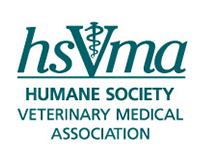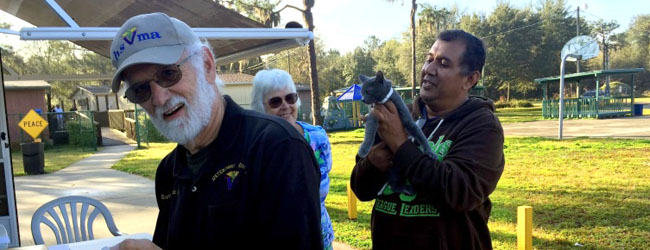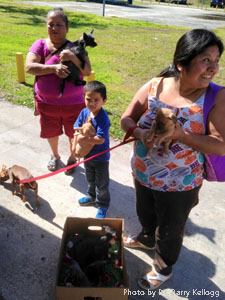The real joy in being an HSVMA member…an outreach projectMay 20, 2016
My favorite talk to give for HSVMA’s Speakers Bureau is the “Dare To Do” talk. In that presentation, I explore the concept of stepping out of your comfort zone to do something that you judge is worthwhile. Sometimes when we get frustrated with slow progress in what we are trying to do in our regular life, we need to just go do something else—even if it takes us out of our comfort zone. That is exactly what happened when my wife, Sally, and I decided to undertake an outreach to the migrant farmworker community in Florida. After my deployment to Hurricane Katrina in 2005, I was so frustrated with the failures in the federal response to that disaster that I came home very depressed and disappointed. Shortly thereafter, Hurricane Wilma struck Florida. I remember reading an article in the local paper that featured a photo of a 5-year-old girl carrying supplies over her head in waist-deep water. The title for the picture was “The Forgotten Communities in Disasters.” Sally and I did not speak Spanish, but I knew right then we had to step out of our comfort zones and do something to help. The migrant farm worker community has always held a special place in our hearts due to the work they provide and the contributions they continually make to our country and economy. So I enlisted the help of my wife and mother-in-law, bought a whole bunch of requested supplies (baby formula, diapers, water and canned food), and took off for the town of Immokalee, Fla., where the migrant community lived. In an hour and a half, we successfully distributed - with the help of a young, local Spanish-speaking gal - all of the supplies we brought and immediately felt…“there, we did something.”
The two major motivating factors/needs for the project were as follows:
To enlist help in reaching out to the community about pet vaccinations, we reached out to an organization called Beth-El Farmworker Ministry in Wimauma, Fla. The group is a USDA “Stop Hunger” program partner, which distributes bags of groceries each Tuesday to about 500 families in that community. Beth-El Farmworker Ministry readily accepted our offer for a partnership, so off we went with our freshly-printed yard signs – in Spanish! – advocating for free vaccination of pets. Although suspicious at first, and reserved regarding acceptance of the program, we were able to enlist a community-based translator and eventually gained the community’s trust. Over several weeks’ time, were able to vaccinate about 400 animals against rabies! We also did a dozen spay/neuters and removed two massive mammary tumors from an 8-year-old Chihuahua who had never been to a veterinarian. We look forward to going back in early 2017 to carry on with the program! I proudly wear my HSVMA hat and t-shirt as a member of an organization that gets things done—sometimes slowly, sometimes right away. |


 Basic veterinary care is just beyond the economic reach of migrant farm families, who only earn between $11,000 and $20,000 per year. This is in addition to the increasing cost of veterinary services. We are reaching a crisis of sorts in the veterinary profession, with appropriate access to care being a real issue for a significant segment of our population. Although we at HSVMA have been instrumental in helping to form
Basic veterinary care is just beyond the economic reach of migrant farm families, who only earn between $11,000 and $20,000 per year. This is in addition to the increasing cost of veterinary services. We are reaching a crisis of sorts in the veterinary profession, with appropriate access to care being a real issue for a significant segment of our population. Although we at HSVMA have been instrumental in helping to form